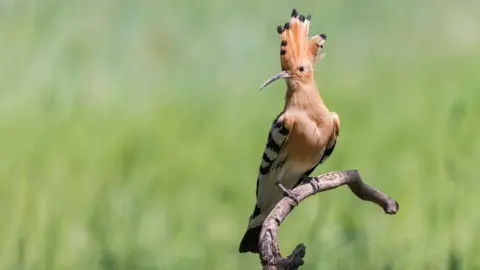Hoopoe spotted near Ipswich likely to be confused - BTO
 Getty Images
Getty ImagesA bird with a distinctive headcrest that usually only visits the south coast of England is thought to have got "confused" and landed in Ipswich.
Jason Alexander said it "made my day" when he spotted a hoopoe land in a tree in a garden.
The RSPB confirmed it was a hoopoe after he posted a video on Facebook.
The British Trust for Ornithology said there were only 120 sightings of them in the UK a year and it was a "real treat" for anyone to see one.
A spokesman for the Norfolk-based charity said more than half of those sightings would normally be on the English Channel coast during the main spring and summer migration periods.
"You get the odd confused bird that's come this way," he said.
"They are from warm southern Europe areas so it is out of place in suburban Ipswich."
The BTO said it had seen an increase in the number of many species associated with southern Europe but for unknown reasons it had not seen a similar increase in the number of hoopoes turning up in Britain.
Allow Facebook content?
Mr Alexander, who founded social enterprise Rubbish Walks, said the bird was "one of the last things I expected to see, particularly in November".
"I never would've seen it if I wasn't taking the new puppy for a walk," he said.
"It was great to see and that's a species to tick off the list, chances are I will never see one again."
He says he saw it fly up to a tree and at first thought it was a woodpecker before seeing its distinctive black and white wings, long black downcurved bill and long pinkish-brown crest.
The RSPB said the hoopoe, which is the size of a mistle thrush, was not native to the UK and did not breed in this country, but could be seen if it overshot its more common European nesting sites when migrating north from Africa.

Find BBC News: East of England on Facebook, Instagram and Twitter. If you have a story suggestion email [email protected]
